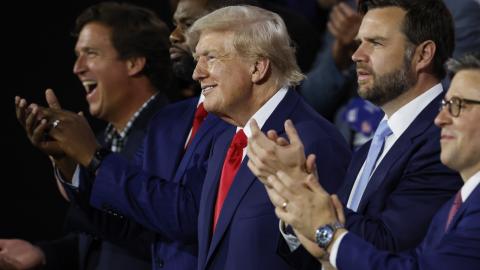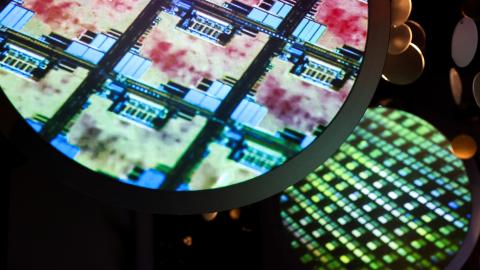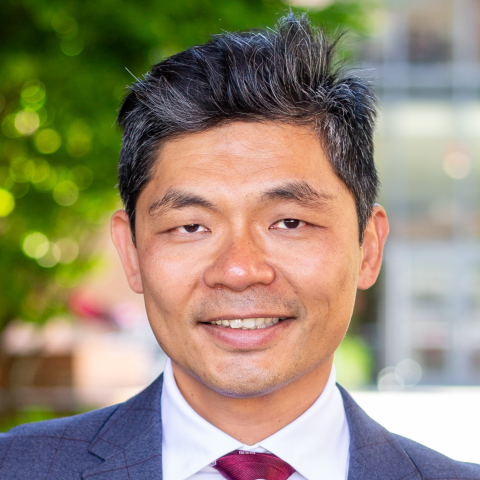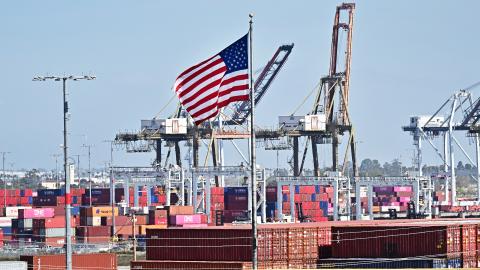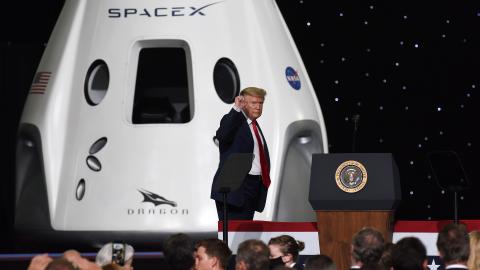Silicon Valley can’t wait for Donald Trump’s inauguration.
The high-tech bias of Trump’s second term in the White House became apparent when his former opponent for the Republican nomination, biotech billionaire Vivek Ramaswami, turned into one of his closest supporters, and tech-smart venture capitalist JD Vance became his vice-presidential pick.
Then along came Elon Musk, followed by another former Pay Pal founder, David Sacks (a third Pay Pal alumnus, Palantir co-founder Peter Thiel, has been behind Trump since his first term).
Now Mark Zuckerberg wants to get into act, offering to take “an active role” in shaping Trump’s tech policy. Meanwhile,Trump’s latest admirer from high-tech heaven, Amazon founder and executive chairmanJeff Bezos, has said he is very optimistic about working with a “calmer” Donald Trump during his second turn in the White House.
In fact, Bezos, Zuckerberg, and OpenAI CEO Sam Altman are contributing $1 million each to the fund for Trump‘s inaugural festivities.
At age 78, Donald Trump would seem an unlikely candidate for enthusiastically making high-tech the hallmark of his presidency. Yet the truth is, as an entrepreneur and founder himself, he understands the importance of harnessing tech innovation in order to make America Great Again—and for the future of the global order.
We can see this clearly reflected in his fascination with cryptocurrencies, especially Bitcoin. In a previous column I wrote how candidate Trump promised to bring crypto into the financial mainstream, even establishing a strategic Bitcoin reserve worth up approximately $14 billion.
Now as president-elect Trump clearly intends to keep his promises. There’s going to be a major shake-up at the Security and Exchange Commission, where Trump will appoint pro-crypto Paul Atkins with the task of breaking the regulatory logjam over whether cryptocurrencies like Bitcoin and Ethereum are securities or commoditys.
Trump has also chosen someone to head the U.S. Treasury Department who is sympathetic to crypto. Scott Bessent, founder of Key Square Group and former Soros Fund Management investing chief, is “very pro-crypto,” according to reports. Bessent has expressed his positive stance on cryptocurrencies, especially Bitcoin, which brings him in alignment with Trump’s ambitious promise to make the US the “crypto capital of the planet.”
To round out the team, Trump has also named a Crypto/AI “czar” to oversee policy on both technologies. That’s former Pay Pal co-founder David Sacks. “He will work on a legal framework so the Crypto industry has the clarity it has been asking for, and can thrive in the U.S.,” Trump noted in a post on his social-media site Truth Social.
Overall, what the crypto community will be looking for from the Atkins/Bessent/Sacks troika is not no regulation, but rather clarity at last after the confusions foisted on it by the current SEC commissioner, Gary Gensler. Instead, with this troika, Trump’s vision of crypto as an investment vehicle that’s here to stay; and that can bolster the use of the US dollar as reserve currency; will be closer to fulfillment.
The appointment of Sacks as AI czar also signals big changes in federal policy toward AI/ML The Biden administration has been characteristically slow and hesitant in dealing with the global AI surge and has only acted after checking in with big stakeholders in AI like Microsoft, Google, and Nvidia, during highly orchestrated White House meetings.
Expect to see the federal reins on AI development seriously loosen, with the burden of proof of the need for regulation falling on regulators, not on AI companies themselves. And AI czar Sacks will be prioritizing regulations that affect how AI is used in certain critical applications, instead of focusing on regulating the development of AI applications themselves.
Certainly the U.S. equity markets have been experiencing “AI mania” for the past year. It’s a trend that’s only grow stronger. By one reliable estimate, the global AI market is expected to reach $2.74 trillion by 2032. That’s over four times more than this year’s $621.19 billion.
And it’s not just markets that are going AI crazy. Internet searches for AI degrees hit a five-year record this week, with 2024 inquiries reaching 1.7 million compared to half a million just four years ago, in 2020. In tech-oriented states like California, Washington (home of Microsoft), New York, and Oregon, AI specialists are being paid substantially more than their counterparts in the rest of the United States. In fact, knowing AI programming languages like Rust and Golang can boost a job salary by $20k-30k on average. Potential employers prefer that knowledge to having a PhD.
AI chip designer Nvidia reaped all the benefits from the relentless AI enthusiasm this year, as it rose to a stellar $3.3 trillion market cap, making it the most valuable company in the world. Yet the Biden administration’s response to Nvidia’s success has not been congratulations, but putting the company under investigation by the Federal Trade Commission (FTC) and the U.S. Department of Justice (DOJ) for potential antitrust violations. In fact, under Biden fully 40 percent of the S&P 500 companies are under some kind of investigation by federal agencies.
Expect that anti-business bias to vanish under President Trump. Likewise, a smart AI policy under Trump won’t just focus on the currently hot field of generative AI. It would look to expand the AI universe to support a range of other economic uses, from manufacturing and industrial processes, to mining, agriculture, energy extraction, and in space. Not to mention the use of AI for national defense, where companies like Palantir are bound to expand their reach under the Trump regime.
Until now China has been the pace setter when it comes to AI as a national strategy, and a national investment to match (more than $150 billion). Expect to see a Trump surge in the appreciation of AI as an instrument of American national power. The difference will be Trump looking to unleash the power of a highly innovative and productive private sector, rather than cobbling together a costly, ungainly, and top-heavy AI “industrial policy.”
A similar opportunity looms in terms of quantum technology. It was President Trump in his first administration who signed the original National Quantum Initiative in 2018. He will be there to sign the $2.7 billion NQI reauthorization bill when it emerges from the Senate and Congress. Much has happened since then, including a fuller awareness of the potentially catastrophic threat of a large-scale quantum computer to all conventional digital encryption systems.
Therefore, it’s time for the Trump administration to follow up closely on the series of executive orders and legislation from the Biden years, e.g. the Quantum Computing Cybersecurity Preparedness Act of 2022, that required critical government agencies to set timelines for a plan to implement quantum-secure encryption.
The next step will be requiring government agencies to set a deadline for actual implementation while requiring private industry to do the same, especially U.S. financial markets. By working with the financial industry and national defense agencies, including the Pentagon, a comprehensive Trump quantum security program can take shape.
This will be cheaper and quicker than skeptics imagine. Quantum security will rest not just on post-quantum cryptography (PQC) allgorithms, but on hybrid solutions of the kind that companies like Quantum e Motion and Qusecure and Entanglement Inc in North America, and quantum key distribution (QKD) solutions by IDQuantique in Switzerland, among others.
It‘s time for the federal government to ignore the quantum skeptics and reach out to an entire section of the global quantum security industry it has neglected until now, but which has proven results in this country as well as in Europe and Asia, including South Korea, and is ready to scale globally.
In short, Trump’s quantum team will need to focus on making America quantum-ready and quantum-secure, as well as winning the quantum computing race with China. There can be no excuses for failure to achieve quantum supremacy, as well as AI supremacy, in the next decade.
Finally, we come to space. Here Elon Musk, the wizard of Space-X, has shown how a private company could breathe new life into space exploration and space launch. Space-X has been joined by a host of other firms who are transforming what experts call New Space, including large players like Sierra Space, Maxar, and Bezos’s Blue Origin, as well as smaller companies like satellite maker Astranis.
This transformation of space via private commercial enterprise has been nothing less than astonishing. The global space economy has nearly doubled in size over the last decade, with U.S. companies accounting for 50% of all space-related private investment and 87% of all launch-specific investment. A Trump space-savvy policy will need to fully harness to not only expand economic opportunities, but also gear up for the grim possibility of future war in space with China or Russia.
Here Trump’s space policy will rely on another tech billionaire, Jared Isaacman, whom he’s chosen to head NASA, to build closer cooperation between NASA, the commercial space industry, and another Trump creation, the U.S. Space Force, in order to project American “space supremacy” and protect the next Great Commons in space.
Meanwhile, America’s most trusted allies can help.
One is Japan. The United States is still the country with the single biggest investment in space, at more than 73 billion dollars. But Japan is now the third largest space investor after China, and is poised to invest even more, with one trillion yen set aside for space development and another trillion for space security.
Another place to look is India. India would make an impressive ally in space, with its 124 active satellites circling the globe. In fact, India is one of only four countries to make a successful moon landing, on a budget smaller than many Hollywood movies—$74 million.
At the same time, it’s important not to overlook South Korea. Korea’s space enterprises are overseen by the Korea AeroSpace Administration (KASA), which is actively developing its own space launch capabilities. Seoul aims to become a major space power, with plans for a lunar landing and lunar exploration, a dedicated satellite navigation system (Korean Positioning System - KPS), and close collaboration with NASA, as well as developing Korea’s own rockets like the “Nuri” (KSLV-II).
Korea as well as Japan can also be valuable collaborators for NASA and U.S. space industry in bringing quantum communications into space via a joint quantum satellite.
Moving through all these high-tech arenas will be a president who seems to have taken to heart one of Elon Musk’s favorite sayings, “Move fast, blow things up.” What’s coming under a Trump second term is not just a high-tech boom, starting with crypto. It’s also destined to be a revolution in government, the most important for America in 120 years.
Read in Korea Business Herald.
Enjoyed this op-ed? Subscribe to Hudson’s newsletters to stay up to date with our latest content.



